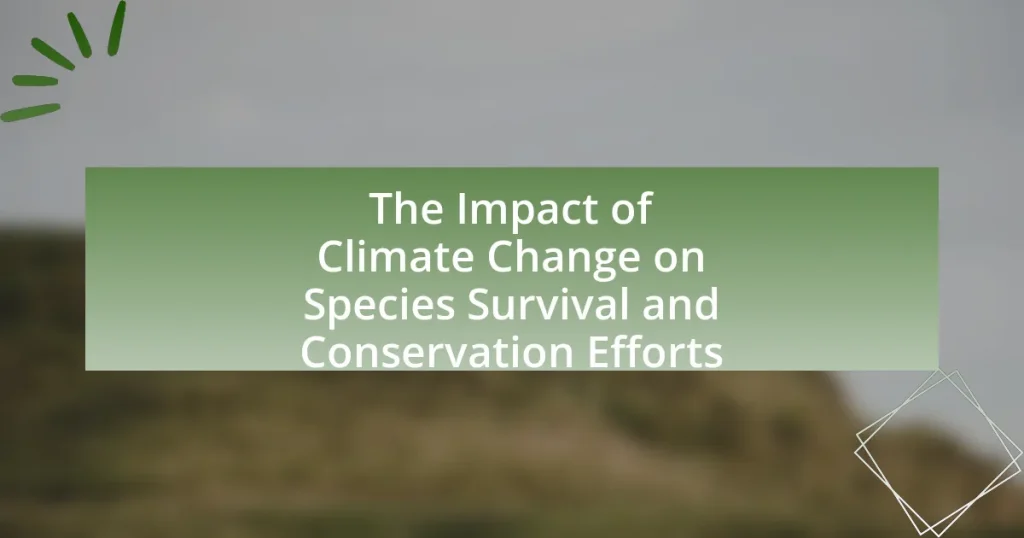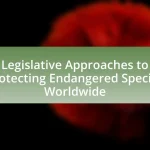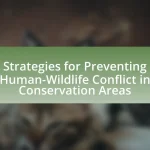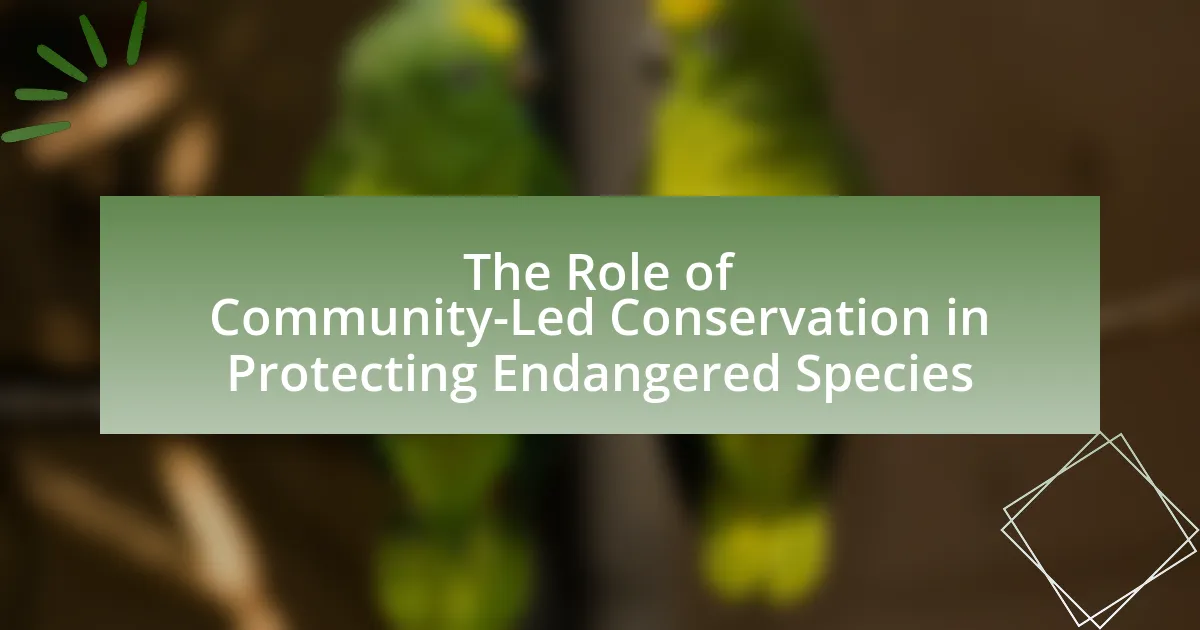The article examines the significant impact of climate change on species survival and conservation efforts. It highlights how rising temperatures, habitat loss, and altered ecosystems threaten biodiversity, with studies indicating that up to one million species face extinction due to climate-related factors. The discussion includes specific vulnerable species, the ecological consequences of extinction, and the importance of conservation strategies such as habitat restoration and protected areas. Additionally, it addresses the challenges faced in conservation efforts, the role of community engagement, and the necessity of funding and education in promoting effective conservation initiatives.
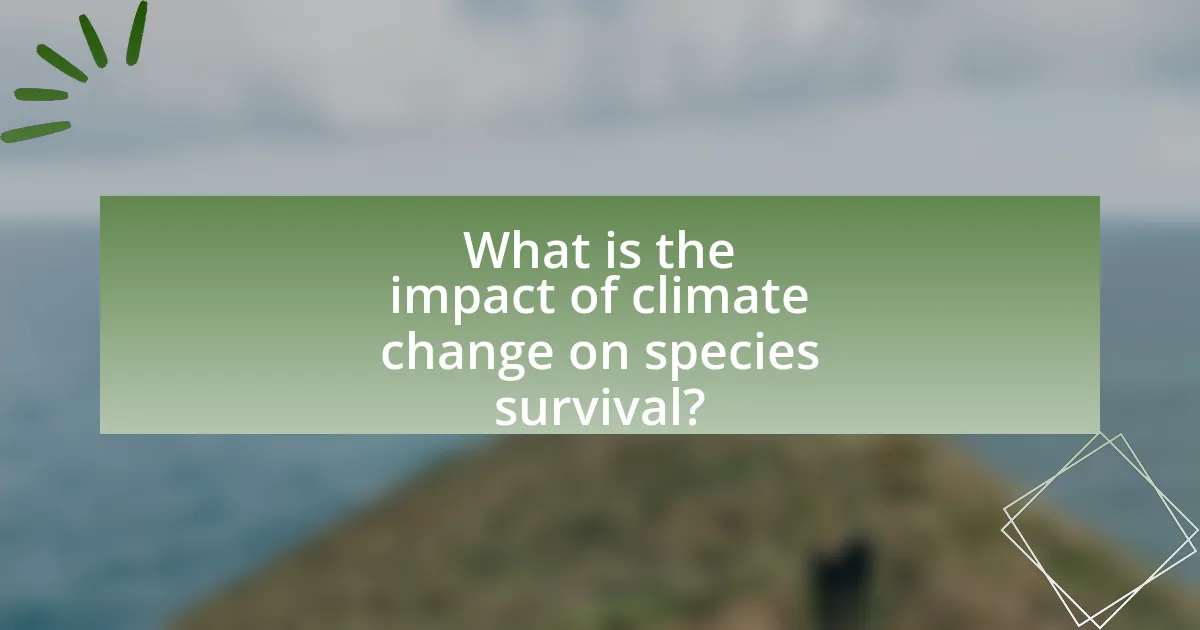
What is the impact of climate change on species survival?
Climate change significantly threatens species survival by altering habitats, disrupting ecosystems, and increasing extinction rates. Rising temperatures and changing precipitation patterns lead to habitat loss, making it difficult for many species to adapt or migrate. For instance, a study published in the journal “Nature” found that climate change could push one in six species to extinction by 2100 if current trends continue. Additionally, ocean acidification and warming waters threaten marine biodiversity, impacting species such as coral reefs, which are vital for numerous marine organisms. These changes create a cascade effect, disrupting food webs and ecological balance, ultimately jeopardizing the survival of various species.
How does climate change affect biodiversity?
Climate change significantly affects biodiversity by altering habitats, disrupting ecosystems, and leading to species extinction. As global temperatures rise, many species struggle to adapt to changing conditions, resulting in shifts in distribution and population declines. For instance, a study published in “Nature” by Thomas et al. (2004) indicates that approximately 1 million species are at risk of extinction due to climate-related factors such as habitat loss and changing precipitation patterns. Additionally, coral reefs, which support diverse marine life, are severely impacted by ocean warming and acidification, leading to coral bleaching and loss of associated species. These changes threaten the balance of ecosystems, ultimately affecting species survival and conservation efforts.
What specific species are most vulnerable to climate change?
Coral reefs, polar bears, and certain amphibians are among the species most vulnerable to climate change. Coral reefs are highly sensitive to temperature changes and ocean acidification, leading to widespread bleaching events that threaten their survival. Polar bears rely on sea ice for hunting seals, and the loss of ice due to rising temperatures severely impacts their ability to find food. Amphibians, such as the golden toad, are particularly susceptible to changes in moisture and temperature, which can lead to habitat loss and increased disease prevalence. These species exemplify the broader impacts of climate change on biodiversity, as evidenced by studies indicating that climate change is a significant driver of species extinction risk.
How do changing habitats influence species survival rates?
Changing habitats significantly influence species survival rates by altering the availability of resources, breeding grounds, and shelter. For instance, habitat loss due to climate change, such as deforestation or ocean acidification, can lead to decreased food sources and increased competition among species. A study published in the journal “Nature” by Bellard et al. (2012) indicates that climate change could cause a 15-37% increase in extinction rates for various species by 2050, primarily due to habitat changes. This evidence underscores the critical relationship between habitat stability and species survival, demonstrating that as habitats change, the likelihood of species survival diminishes.
Why is species extinction a concern in the context of climate change?
Species extinction is a concern in the context of climate change because it disrupts ecosystems and diminishes biodiversity, which are crucial for maintaining ecological balance. The loss of species can lead to the collapse of food webs, as seen in the decline of pollinators like bees, which are essential for the reproduction of many plants. According to the Intergovernmental Panel on Climate Change (IPCC), climate change is projected to increase extinction risks for approximately one million species globally, primarily due to habitat loss, altered weather patterns, and shifting ecosystems. This decline in biodiversity not only affects the natural environment but also threatens human livelihoods, food security, and health, as ecosystems provide vital services such as clean air, water, and disease regulation.
What are the ecological consequences of species extinction?
Species extinction leads to significant ecological consequences, including the disruption of food webs and loss of biodiversity. When a species disappears, it can create a ripple effect throughout its ecosystem, as other species that rely on it for food, habitat, or other ecological functions may also decline or vanish. For instance, the extinction of a predator can result in an overpopulation of prey species, which can lead to overgrazing and habitat degradation. According to the Intergovernmental Science-Policy Platform on Biodiversity and Ecosystem Services (IPBES), approximately 1 million species are currently threatened with extinction, which poses a serious risk to ecosystem stability and resilience. This loss of biodiversity undermines ecosystem services such as pollination, water purification, and carbon storage, ultimately affecting human well-being and the health of the planet.
How does the loss of biodiversity affect ecosystem services?
The loss of biodiversity negatively impacts ecosystem services by reducing the variety of species that contribute to essential ecological functions. Biodiversity supports processes such as pollination, nutrient cycling, and water purification, which are vital for maintaining healthy ecosystems. For instance, a study published in the journal “Nature” found that ecosystems with higher species diversity are more resilient to environmental changes and provide more reliable services, such as food production and climate regulation. Therefore, diminished biodiversity leads to weakened ecosystem stability and a decline in the quality and quantity of services that ecosystems provide to humans and the environment.
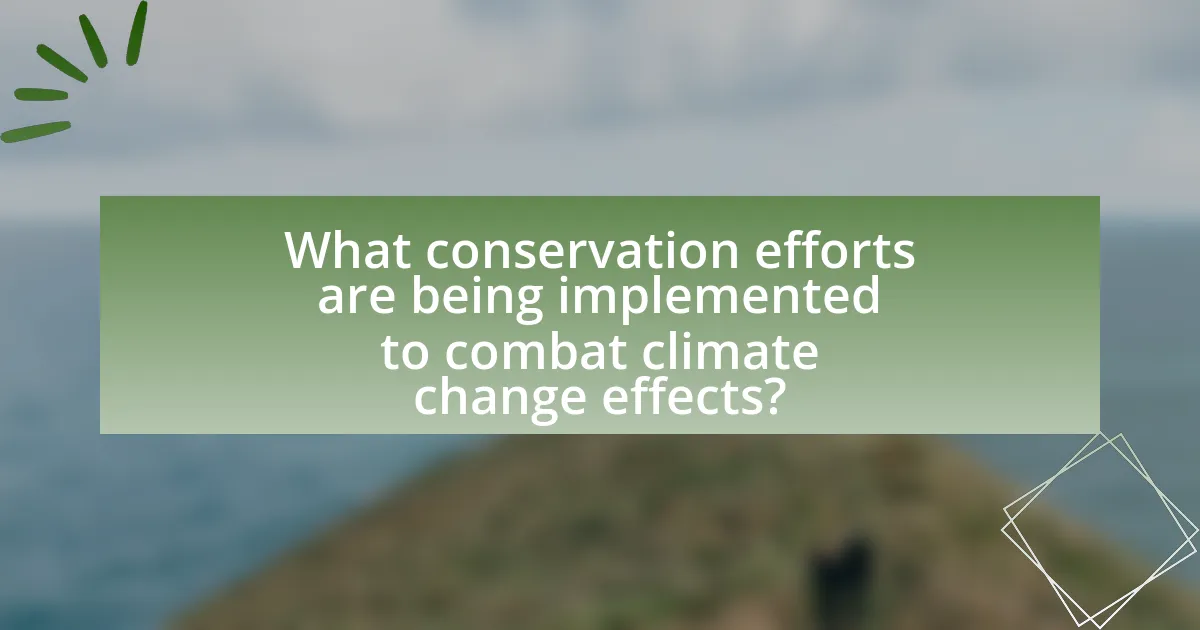
What conservation efforts are being implemented to combat climate change effects?
Conservation efforts to combat climate change effects include habitat restoration, protected area expansion, and species management programs. Habitat restoration initiatives aim to rehabilitate ecosystems that have been degraded, which enhances biodiversity and resilience against climate impacts. Protected area expansion involves increasing the number and size of reserves to safeguard critical habitats and species from climate-related threats. Species management programs focus on monitoring and supporting vulnerable species through breeding programs and relocation strategies to ensure their survival in changing environments. These efforts are supported by scientific research indicating that preserving biodiversity is essential for ecosystem stability and resilience against climate change.
How are conservation strategies adapting to climate change?
Conservation strategies are adapting to climate change by incorporating climate resilience into their planning and implementation processes. These strategies now prioritize the protection of ecosystems that can withstand climate impacts, such as habitat restoration and the establishment of wildlife corridors to facilitate species migration. For example, the National Oceanic and Atmospheric Administration (NOAA) emphasizes the importance of adaptive management practices that allow for flexibility in response to changing environmental conditions. Additionally, the integration of climate data into conservation decision-making helps identify vulnerable species and ecosystems, enabling targeted interventions. This approach is supported by research from the Intergovernmental Panel on Climate Change (IPCC), which highlights the necessity of adaptive strategies to mitigate the effects of climate change on biodiversity.
What role do protected areas play in species conservation?
Protected areas play a crucial role in species conservation by providing safe habitats that protect biodiversity from threats such as habitat destruction, climate change, and invasive species. These designated regions help maintain ecological balance and allow for the preservation of critical ecosystems, which are essential for the survival of numerous species. For instance, a study published in “Nature” by Watson et al. (2014) found that protected areas are effective in reducing species extinction rates by up to 50% compared to unprotected areas. This demonstrates that the establishment and management of protected areas are vital strategies in mitigating the impacts of climate change on species survival and ensuring the long-term viability of diverse ecosystems.
How can habitat restoration contribute to species survival?
Habitat restoration contributes to species survival by re-establishing the natural environments that species depend on for food, shelter, and breeding. Restored habitats can enhance biodiversity, allowing various species to thrive and adapt to changing climate conditions. For instance, a study published in the journal “Ecological Applications” found that restored wetlands can support up to 50% more bird species compared to degraded areas, demonstrating the direct link between habitat quality and species diversity. Additionally, habitat restoration can mitigate the effects of climate change by improving ecosystem resilience, which is crucial for the survival of vulnerable species.
What are the challenges faced in conservation efforts due to climate change?
Conservation efforts face significant challenges due to climate change, primarily including habitat loss, altered species distributions, and increased frequency of extreme weather events. Habitat loss occurs as rising temperatures and changing precipitation patterns disrupt ecosystems, leading to the degradation of critical habitats for many species. Altered species distributions result from shifting climatic conditions, forcing species to migrate to new areas, which can lead to conflicts with human activities and other species. Additionally, increased frequency of extreme weather events, such as floods and droughts, can destroy habitats and threaten the survival of vulnerable species. These challenges complicate conservation strategies, making it difficult to protect biodiversity effectively.
How does funding impact conservation initiatives?
Funding significantly impacts conservation initiatives by providing the necessary financial resources to implement and sustain projects aimed at protecting biodiversity and ecosystems. Adequate funding enables organizations to conduct research, engage in habitat restoration, and support community-based conservation efforts. For instance, a study by the World Wildlife Fund indicates that conservation projects with stable funding are 50% more likely to achieve their goals compared to those with inconsistent financial support. This correlation highlights the critical role of funding in ensuring the effectiveness and longevity of conservation initiatives.
What are the limitations of current conservation practices?
Current conservation practices face significant limitations, primarily due to insufficient funding, lack of comprehensive data, and inadequate integration of climate change considerations. Insufficient funding restricts the scope and effectiveness of conservation initiatives, as many programs operate on limited budgets that hinder their ability to implement long-term strategies. Additionally, the lack of comprehensive data on species populations and ecosystems complicates the development of targeted conservation efforts, leading to ineffective resource allocation. Furthermore, many conservation strategies do not adequately incorporate the impacts of climate change, which can alter habitats and species distributions, rendering traditional methods obsolete. For instance, a study published in “Nature Climate Change” highlights that over 50% of conservation plans do not account for climate change projections, undermining their effectiveness in protecting biodiversity.
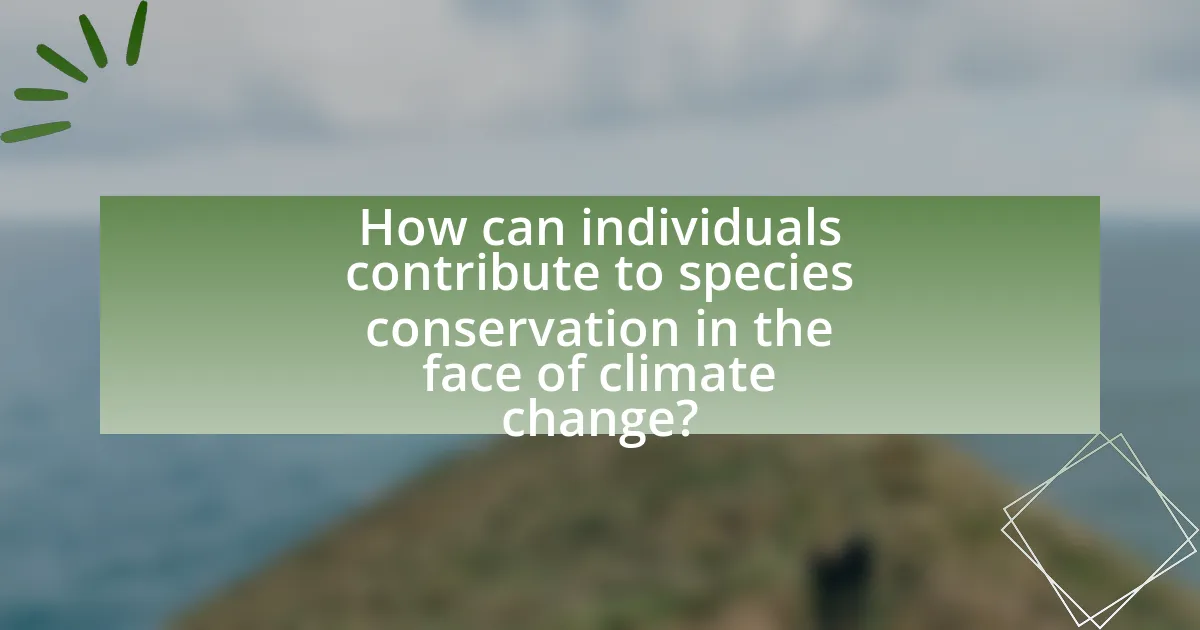
How can individuals contribute to species conservation in the face of climate change?
Individuals can contribute to species conservation in the face of climate change by adopting sustainable practices, supporting conservation organizations, and advocating for policy changes. Sustainable practices include reducing carbon footprints through energy conservation, using public transportation, and minimizing waste, which collectively help mitigate climate change impacts on habitats. Supporting conservation organizations, such as the World Wildlife Fund or local wildlife trusts, provides essential funding and resources for species protection initiatives. Advocacy for policy changes, including promoting legislation that addresses climate change and habitat preservation, empowers individuals to influence systemic change that benefits biodiversity. These actions are crucial as studies indicate that climate change threatens over one million species with extinction, highlighting the urgent need for collective individual efforts in conservation.
What actions can individuals take to support conservation efforts?
Individuals can support conservation efforts by participating in local clean-up initiatives, reducing waste, and advocating for sustainable practices. Engaging in community clean-ups helps remove litter from natural habitats, directly benefiting local ecosystems. Reducing waste through recycling and composting minimizes landfill contributions, which can harm wildlife. Advocating for sustainable practices, such as supporting renewable energy and responsible consumption, influences policy changes that protect endangered species and their habitats. According to the World Wildlife Fund, individual actions collectively contribute to significant environmental improvements, demonstrating the power of grassroots involvement in conservation.
How does reducing carbon footprints help species survival?
Reducing carbon footprints helps species survival by mitigating climate change, which is a primary threat to biodiversity. Climate change leads to habitat loss, altered ecosystems, and increased frequency of extreme weather events, all of which endanger various species. For instance, a study published in the journal “Nature” found that a reduction in greenhouse gas emissions could prevent the extinction of up to 1 million species by maintaining stable habitats and ecosystems. By lowering carbon emissions, we can help preserve the delicate balance of ecosystems, ensuring that species have the resources and environments they need to thrive.
What role does community engagement play in conservation success?
Community engagement is crucial for conservation success as it fosters local stewardship and enhances the effectiveness of conservation initiatives. Engaged communities are more likely to support and participate in conservation efforts, leading to better resource management and protection of biodiversity. For instance, studies have shown that when local populations are involved in decision-making processes, conservation projects have a higher success rate, as seen in the case of community-managed marine protected areas in the Philippines, which resulted in increased fish populations and improved livelihoods. This demonstrates that active participation not only empowers communities but also aligns conservation goals with local needs, ultimately contributing to the sustainability of ecosystems in the face of climate change.
What are the best practices for promoting species conservation?
The best practices for promoting species conservation include habitat protection, sustainable resource management, and community engagement. Habitat protection involves safeguarding critical ecosystems to ensure species have the necessary environment to thrive; for instance, protected areas have been shown to effectively conserve biodiversity, with studies indicating that such areas can reduce species extinction rates by up to 50%. Sustainable resource management focuses on balancing human needs with ecological health, which can be achieved through practices like regulated fishing and forestry that prevent overexploitation. Community engagement is crucial, as involving local populations in conservation efforts fosters stewardship and increases the likelihood of success; research has demonstrated that community-led initiatives can lead to a 30% increase in conservation outcomes. These practices collectively enhance the resilience of species against the impacts of climate change and promote long-term biodiversity conservation.
How can education and awareness campaigns enhance conservation efforts?
Education and awareness campaigns enhance conservation efforts by increasing public understanding of environmental issues and promoting sustainable practices. These campaigns inform communities about the impacts of climate change on biodiversity, leading to greater support for conservation initiatives. For instance, a study published in the journal “Conservation Biology” found that educational programs significantly improved knowledge and attitudes towards endangered species, resulting in increased participation in local conservation activities. By fostering a sense of responsibility and connection to the environment, education and awareness campaigns mobilize individuals and communities to take action, ultimately contributing to the preservation of species and ecosystems affected by climate change.
What partnerships can be formed to strengthen conservation initiatives?
Collaborative partnerships between governmental agencies, non-governmental organizations (NGOs), local communities, and private sector stakeholders can significantly strengthen conservation initiatives. These partnerships enable resource sharing, knowledge exchange, and coordinated efforts to address the multifaceted challenges posed by climate change on biodiversity. For instance, the collaboration between the World Wildlife Fund (WWF) and various governments has led to successful conservation projects that protect endangered species and their habitats, demonstrating the effectiveness of such alliances in achieving conservation goals.
